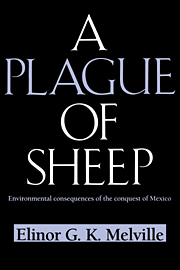Book contents
- Frontmatter
- Contents
- Illustrations and Tables
- Preface
- Chapter 1 Introduction
- Chapter 2 Alien Landscapes
- Chapter 3 The Australian Experience
- Chapter 4 The Mexican Case
- Chapter 5 The Conquest Process
- Chapter 6 The Colonial Regime
- Appendix A Sub-Areas
- Appendix B Population Estimates
- Appendix C Sources for Land Holding and Land Use
- Abbreviations
- Glossary
- Bibliography
- Index
Chapter 1 - Introduction
Published online by Cambridge University Press: 05 August 2012
- Frontmatter
- Contents
- Illustrations and Tables
- Preface
- Chapter 1 Introduction
- Chapter 2 Alien Landscapes
- Chapter 3 The Australian Experience
- Chapter 4 The Mexican Case
- Chapter 5 The Conquest Process
- Chapter 6 The Colonial Regime
- Appendix A Sub-Areas
- Appendix B Population Estimates
- Appendix C Sources for Land Holding and Land Use
- Abbreviations
- Glossary
- Bibliography
- Index
Summary
The Biological Conquest of the New World
What happened after the military deeat of the Aztecs, the Incas, and the myriad towns and city states of the New World? How did the Spaniards and the Europeans who followed them into the New World extend their control over the countryside? This more prosaic, less swashbuckling, less colorful aspect of conquest is crucial for a lasting result, and overall the Europeans were as successful in this as they had been in the military conquests.
The Europeans' success can, in great part, be ascribed to the fact that they did not come alone to the New World, but brought with them animals and plants; weeds, seeds, and diseases. In Alfred Crosby's evocative terminology they traveled with their “portmanteau biota”. The Spaniards, for example, did not travel with just their horses and war dogs – they also brought more ordinary animals such as pigs, chickens, sheep, goats, and cattle. They imported grains like wheat and barley, as well as fruit trees, grapevines, and flowers. Weeds came attached to fur and hair and in the seedstock; and pests such as rats came in ships' holds. The conquistadors also carried with them Old World pathogens. The invaders had brought with them more means than they knew to conquer a continent.
- Type
- Chapter
- Information
- A Plague of SheepEnvironmental Consequences of the Conquest of Mexico, pp. 1 - 16Publisher: Cambridge University PressPrint publication year: 1994

